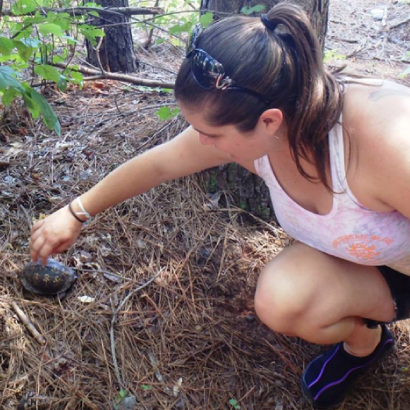
When I took my first outdoor recreation job, I had no background in environmental science. Worried, I confessed to a co-worker that I didn’t even know how to tell tree species apart. She lent me a tree identification book so thick I wondered how many trees it took to print it. I opened it once, was overwhelmed by hundreds of trees that all just looked like trunks and leaves, and gave up.
As part of training, a forester came to our facility to take us on a hike and tell us a little about the natural history of the area. I brought a notebook and asked for the species of each tree he pointed out. I wrote each one down, along with some relevant facts such as invasive species they were vulnerable to or whether bats used them to roost, but still was no better at telling the species apart.
It wasn’t until I went for a walk with another co-worker that I learned how to look at trees.
“See how this bark peels away vertically from the trunk? This is a shagbark hickory. And this one’s easy – the leaf is shaped like the one on Canada’s flag. It’s a sugar maple. Check out how the needles are grouped on this pine – they’re in groups of five, so that’s a white pine.”
My co-worker was touching the trees, pulling branches down for me to see closer, encouraging me to feel the bark. This was the first time I realized what makes each tree species, and even each tree, unique. I just hadn’t known what to look for. It was the “aha!” moment every teacher, counselor, coach, mentor and leader hopes to see again and again once they’ve seen it once.
While people can learn a lot from reading a book or from a walk-through or demonstration, any veteran nature program leader will tell you that those methods rarely cut it for nature program staff training. If you want your participants to be comfortable and enthusiastic outside, then your staff need to be comfortable and enthusiastic outside, before programming begins. Whether you’re focusing on birds, bugs or trees, nothing compares to actually getting out there.
After years of working in and running nature-based programming, I was introduced to a great program called the Beetles Project by UC Berkeley. Resources for training nature program staff by the Beetles Project can be found here, but in short, these are the four tenets Beetles reinforced for me which I now follow for all of my nature staff trainings:
- Take the staff outside!
- Make sure staff feel safe, but informed (i.e. Yes, poison ivy exists. Here is what it looks like and what to do if you think you’ve touched it. Yes, snakes exist. Here are what the venomous ones in our area look like and what to do if you see one/get bitten, etc.)
- Have the right tools. At minimum, have the tools handy that your participants will use for the activity/class you are training your staff for. I recommend hand lenses all the time to encourage looking more closely.
- Run the activity as a role play with trainees acting as participants. They’ll experience, notice and learn what your participants will, and feel less shy about asking questions.
I can now look at a tree identification book and not get overwhelmed. I even used the list of species from the forester’s hike to create a mini-identification guide specific to the area I was working in for our participants to use.
After, of course, they learned how to look at the trees first.
Editor’s Note: Looking for a nature program to engage your youth in? Download the free Wildlife Explorers workbook. It’s a free 6-week nature discovery program perfect for your out-of-school time programs.
Shannon Burton was an English teacher for three years before moving into the field of outdoor education. She has worked for outdoor facilities and camps in various states since 2008, and is currently the Outdoor Programs Manager for the New Orleans Recreation Development Commission.

